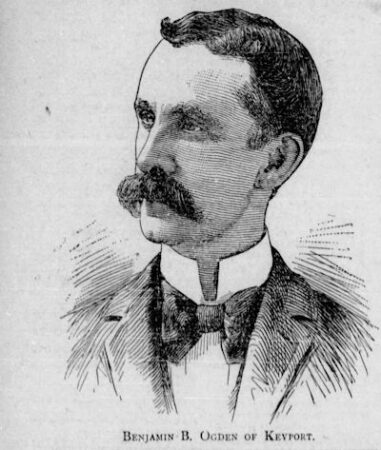By John R. Barrows
By today, September 16, everyone in Keyport finally realized that their mayor was gone.
Missing. Disappeared. Vamoosed. Am-scrayed. On the lam, a fugitive from justice.
In 1903, Benjamin B. Ogden was president of the Keyport town commissioners (a.k.a. mayor). He was also postmaster, president of the school trustees, a director of People’s National Bank, secretary of the Keyport building and loan association, and leader of the Keyport Republican Party.
Prior to attaining his law degree, Ogden had been trained as a harness-maker. Over the years, he ran an ice business and a stationery store in Keyport, and was operator of the steamboat SS Holmdel for a time. He had an office at 127 Broadway in New York City for managing his investments. He was among the most prominent leading citizens of Keyport during his life, until his disappearance.
Ogden, 42, was last seen in Keyport on Friday, September 11, 1903. At that time, it was said by his family that he had gone to Virginia for a rest, but he never returned.
Ogden had been forced to resign as director of the People’s National Bank a few days before. It was said at that time that the bank would lose about $11,000 through bad loans written by Ogden. When he disappeared, he was also in charge of the settlement of several estates in receivership valued at more than $100,000. He also invested large sums for local farmers in the stock markets. Several trust funds disappeared with him.

Ogden was also “deeply interested” in bringing an American Cutlery factory to Keyport, which he backed with thousands of dollars of his own money. Ogden was the principal backer of the American Cutlery factory, which after his disappearance was forced to shut down after falling behind three weeks in payroll for their 75 skilled employees, who all lost their jobs.
“It is said that one of the heaviest losers by Ogden’s alleged crooked transactions is Mrs. Fannie Ogden of…Asbury Park, widow of the late Harry Ogden, a brother of the defaulter,” according to one newspaper report. The mayor’s sister-in-law entrusted Benjamin Ogden with $11,000 to put toward her mortgage. Ogden instead used the money for his own purposes and paid Fannie interest. There was no mortgage. He had even fleeced his own brother’s widow.
His budget shortage at the Keyport building and loan association was $5,288. He similarly left many residents of Monmouth County with financial losses.
He sold his horses and carriages just prior to his departure. It was later found that he had engaged in “a massive number” of real estate transactions in the time before he vanished. A loss was discovered from the post office safe.
On September 19, Ogden’s wife said that she did not know of her husband’s whereabouts, or if or when he might return. About a month after his disappearance, it was reported that a Monmouth County grand jury had handed down “about a dozen” indictments against Ogden, but, “The precise character of the indictments will not be known until Ogden is apprehended.”
A week later, Ogden was declared bankrupt, with liabilities in excess of $100,000 and assets of less than $3,000. Ogden’s house in Keyport was said to be in the name of his wife and mortgaged to its full value. His only child was a daughter, who took over his business affairs in his absence.
In the weeks following his disappearance, local newspapers reported that Ogden’s “intimate friends have had constant knowledge of his movements” and that Ogden “has been kept apprized [sic] of everything that has been doing in connection with his affairs in Monmouth,” but he remained beyond the arm of the law, and no one ever was able to find where he was in hiding. By 1905, the amount of his losses was estimated to be between $100,000 and $200,000. A wanted poster was created and circulated offering a reward of $250 for information leading to his apprehension.
Benjamin Ogden, Fugitive Nashville Piano Tuner?
In 1905, the Nashville Banner reported that a man named Harry Palmer had been arrested under suspicion that he was Benjamin B. Ogden, wanted for embezzlement in New Jersey. According to the report, “The man under arrest has been living here for about a year,” but noted that Palmer “does not follow the [legal] profession nor has he the traits of character as attributed to Ogden, but his physical makeup is almost identical with the description of Ogden sent out in posters offering a reward of $250 for his arrest.”
According to the Banner, “Since coming here, Palmer has worked as a piano tuner and also done some laboratory dental work. Palmer denies he is the man wanted.” About a week later, Harry Palmer was released from custody after a New Jersey detective declared that he was not the wanted man Ogden.
Benjamin Ogden, Fugitive Havana Lawyer?
Most people suspected that Ogden was in hiding somewhere in New York City or Brooklyn, but in 1908, a gentleman who made frequent business trips to Havana claimed to have seen Ogden walk past him there. Later, the man said that had he known of the reward of $250 for information leading to Ogden’s apprehension, he would have taken action, but he did nothing.
Several stories reported that Ogden was practicing law in Havana under an assumed name. There was speculation about law enforcement following up on this and, failing that, that locals who had experienced severe financial losses would mount an effort themselves to bring the fugitive to justice, but there is no record that any effort was made to verify Ogden’s presence in Cuba.
Benjamin Ogden, a Saint in death?
In 1937, “Word was received in Keyport…of the death of Benjamin B. Ogden, 81, formerly of this borough, at the home of his daughter, Mrs. Harry Caton of Alexandria, Va.” The obituary makes no mention of his indictments, financial difficulties, or decades on the lam avoiding authorities. Another obit said that Ogden had been “in the real estate business in Orlando, Fla.” This obit also omitted any mention of any of Ogden’s many problems and allegations of malfeasance. The man comes across after his death as though in life he was a saint.
Part of this may be attributed to the likelihood that the obituaries were placed by Ogden’s daughter, who had taken over Ogden’s various businesses after his disappearance. The Virginia newspapers would not necessarily have known of Ogden’s dubious past in New Jersey from decades earlier. She might well have known – or believed – that he was a profound failure as a financier and businessman, but he was not in his heart and soul a thief.
Another factor in all this is the statute of limitations. Ogden successfully avoided apprehension for more than thirty years. Over that time, the grand jury indictments would have expired. Civil suits would have become impossible, without someone to serve papers on, and statutory limits would have rendered potential civil actions moot as well. In 1903, there were no federal laws regulating securities, so there were no criminal penalties involved. At the time of his death, he may have had no indictments, criminal charges, civil suits or any other penalties pending against him.
There are no indications that Benjamin B. Ogden was a criminal mastermind, or even a deliberate thief. Most people believe that he simply got in too far over his head in his numerous complex financial dealings, and when his investments did not pan out, he then made criminal choices to try hide and recoup his losses, which led to an almost total loss of his assets, most of which had been entrusted to him by others. As there was likely no big pile of stolen money held by the fugitive Ogden that might have made investors whole, eventually, all losses would have been written off, and over time the people of Keyport moved on with a new mayor, a new postmaster, etc.
Keyport’s current town historian, Ms. Angel Jeandron, noted that for Keyport locals at the time, the Ogden affair “was ‘swept under the rug’ in town because he was very well-liked. His involvement in the community was deemed beneficial.”
But the newspaper reports make it clear that the harmful impact of Benjamin B. Ogden’s dubious activities, however well-intended, was felt by many Monmouth County residents for many years.
Sources (in chronological order):
B.B. Ogden Gone; Many Will Lose. (1903). Asbury Park Press, Asbury Park, N.J., September 16, 1903, P. 1.
Wife Does Not Know. (1903). Perth Amboy Evening News, Perth Amboy, N.J., September 19, 1903.
Judge Fort Tells Grand Jury Its Duty (1903). Keyport Weekly, Keyport, N.J., October 23, 1903, P. 1.
B.B. Ogden Adjudged Bankrupt. (1903). Monmouth Democrat, Freehold, N.J., November 12, 1903, P. 1.
In A Receiver’s Hands. (1903). The Daily Register, Red Bank, N.J., November 25, 1903, P. 7.
Man Arrested on Suspicion. (1905). Nashville Banner, Nashville, Tenn., May 19, 1905, P. 7.
Tennessee. (1905). The Chattanooga News, Chattanooga, Tenn., May 23, 1905, P. 8.
Ogden Located in Cuba. (1908). Red Bank Register, June 10, 1908, P. 1.
Benjamin B. Ogden Said to be in Cuba. (1908). The Daily Standard, Red Bank, N.J., June 12, 1908, P. 8.
Now Said to be In Cuba. (1908). Matawan Journal, Matawan, N.J., June 18, 1908, P. 6.
BB Ogden in Cuba. (1908). Long Branch Record, Long Branch, N.J., September 1, 1908, P. 12.
Benjamin B. Ogden. (1937). Matawan Journal, Matawan, N.J., April 1, 1937, P. 6.
Jeandron, Jack. (2003). Keyport: From Plantation to Center of Commerce and Industry. Arcadia Publishing, Charleston, S.C., P. 46.
Image: Keyport Weekly sketch of fugitive mayor B.B. Ogden. Published prior to 1926, public domain.


Leave a Reply